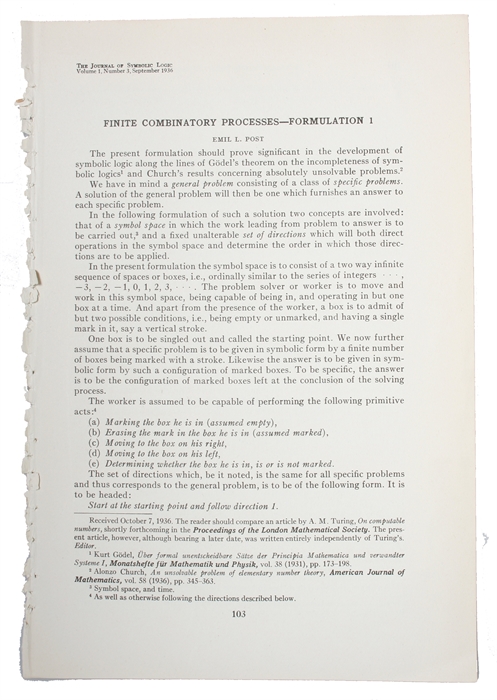A SIMULTANEOUS VERSION OF THE "TURING MACHINE"
POST, EMIL LEON.
Finite Combinatory Processes-Formulation 1. [In: The Journal of Symbolic Logic, Vol. 1, Number 3, Sept. 1936].
[No place], 1936.
8vo. Extract, unbound, unstapled. Pp. 103-105.
The uncommon first printing of Post's seminal paper, in which he, simultaneously with but independently of Turing, describes a logic automaton, which very much resembles the Turing machine. The Universal Turing Machine, which is presented for the first time in Turing's seminal paper in the Proceedings of the London Mathematical Society for 1936 (same year as the present paper), is considered one of the most important innovations in the theory of computation and constitutes the most famous theoretical paper in the history of computing. "Post [in the present paper] suggests a computation scheme by which a "worker" can solve all problems in symbolic logic by performing only machinelike "primitive acts". Remarkably, the instructions given to the "worker" in Post's paper and to a Universal Turing Machine were identical." (A Computer Perspective, p. 125).
"The Polish-American mathematician Emil Post made notable contributions to the theory of recursive functions. In the 1930s, indepently of Turing, Post came up with the concept of a logic automaton similar to a Turing machine, which he described in the present paper [the paper offered]. Post's paper was intended to fill a conceptual gap in Alonzo Churchs' paper on "An unsolvable problem of elementary number theory" (Americ. Journ. of Math. 58, 1936). Church's paper had answered in the negative Hilbert's question as to whether a definite method existed for proving the truth or falsity of any mathematical statement (the Entscheidungsproblem), but failed to provide the assertion that any such definite method could be expressed as a formula in Church's lambda-calculus. Post proposed that a definite method would be written in the form of instructions to a mindless worker operating on an infinite line of "boxes" (equivalent to Turing's machine's "tape"). The worker would be capable only of reading the instructions and performing the following tasks... This range of tasks corresponds exactly to those performed by a Turing machine, and Church, who edited the "Journal of Symbolic Logic", felt it necessary to insert an editorial note referring to Turing's "shortly forthcoming" paper on computable numbers, and ascertaining that "the present article... although bearing a later date, was written entirely independently of Turing's" (p. 103)." (Origins of Cyberspace, pp. 111-12).
Hook & Norman, Origins of Cyberspace, 2002: 355.
Charles & Ray Eames, A Computer Perspective, 1973: 125.
Order-nr.: 42609

